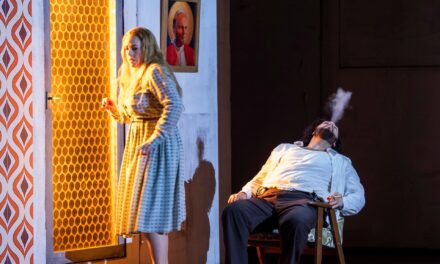The paradox at the heart of Mary Griffiths’ works, collected in a 10-year retrospective at The Stanley & Audrey Burton Gallery in Leeds, is that, for all her openness to collaboration, viewed en masse they can appear somewhat hermetic, as though the pieces are most engaged in conversation with one another.
A similar contradiction is rooted in its form. Mark-making, the etching of pattern into surface, seems to speak of ancient humanity’s first scratchings of expression. Yet Griffiths‘ lines have the precision of modernity – her dark materials are, like the recently discovered graphene, the stuff of 21st century science. Arguably, it’s these tensions beneath their meticulous surfaces, like oceans beneath the fissured ice of outer-planetary moons, that add to the interest of her work.

Mary Griffiths, Everything and All of Us 1 (2)
Displayed in the gallery space alongside her own selections of those who have gone before her, gleaned from the University of Leeds’ cultural collections, they glower distinctly amid the kindred geometric abstractions of Bridget Riley and Barbara Hepworth. If her predecessors can be characterised by an arresting immediacy, for the most part her own works necessitate a closer, more meditative study.
Perhaps the most commanding piece, in terms of its size and directness, is Prophet, a work in plaster and board fitted to the height of the gallery. Commissioned for the exhibition itself and developed in conversation with Tony Crowley, a Professor of English Language at Leeds University who shares a working-class Merseyside background with Griffiths, it’s an evocation of the terraces in Dingle’s Prophet Street that hints at both the homely and the narrow. Griffiths is no stranger to working to a more monumental scale – From Seathwaite, her permanent fixture in the University of Manchester’s National Graphene Institute, spans three of its upper floors.
For the most part, however, Everything and All Of Us, its title derived from a poem by astronomer Rebecca Elson, concerns itself with smaller effects, albeit arrived at through a variety of methodologies. For instance, Graphene Suite, an animation developed in conjunction with the composer Sara Lowes, displays the lost elegance of early computer graphics, rotating the one-atom-thick carbon structure through three dimensions. Beguilingly balletic, it illustrates the beauty that can be found in paying attention to the infinitesimal.
It’s an approach that seems best suited to delineating the cellular or the built. For instance, while Sweet Briar (Yates & Thorn) intends to evoke both the abandoned machinery of Astley Green Colliery and the weeds which have reclaimed it following mining’s cessation, it’s the defined lines of industry that seem to take visual precedence over the unruly extravagance of nature.

Mary Griffiths, For this we go out dark nights 2022
The paradox that the effusions of life should arise somehow from the regularity of chromosomal engines of repetition, predictable at the molecular level, can be read in the complementary grooves of Everything And All Of Us 1 (2). In the decade of vinyl’s resurgence, the piece also seems to allude to the aesthetics of both record and sleeve, reminding the viewer of the worlds of emotions somehow etched into a single coiled spiral.
It’s noteworthy, therefore, that when Griffiths does consider poetry, it’s at one remove, applying the rigour of the bar chart to email exchanges between publisher and readers in the wake of the aforementioned Elson’s death.
There’s rigour in Everything and All Of Us, but it’s a rigidity that, for me, works against emotional engagement. Intellectually satisfying, there’s a sense in which the surfaces remain implacable; the method obscures the madness. If Griffiths can locate the stylus that unleashes the musicality of her grooves, then her works might really sing.
By Desmond Bullen, Chief Arts Correspondent
Main image: Prophet by Mary Griffiths. Photo by Justin Slee. Image courtesy of The Stanley & Audrey Burton Gallery.
Mary Griffiths: Everything and All of Us is at The Stanley & Audrey Burton Gallery, University of Leeds until March 8, 2025. For more information, click here.









